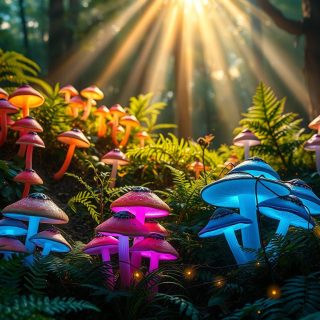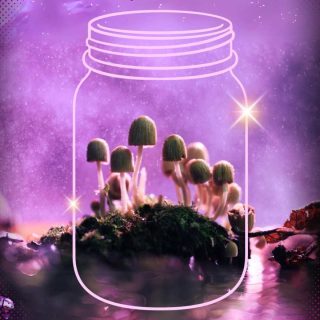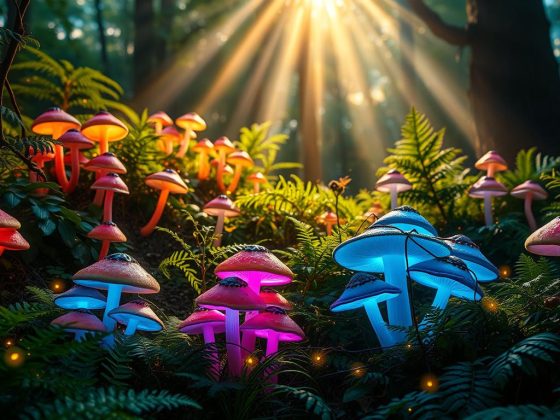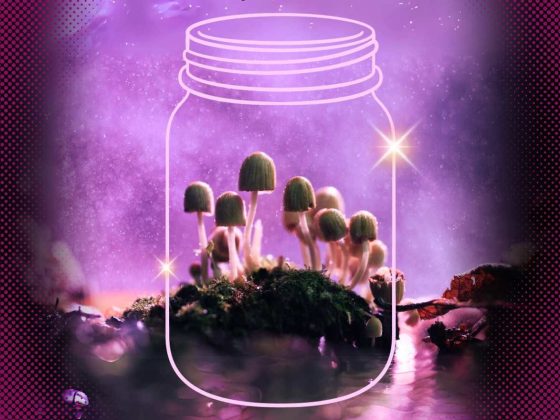Caño Cristales River in Colombia is also known as “the river of five colors” or “liquid rainbow.”
Caño Cristales River, Colombia.
VarnaK/Shutterstock
This body of water actually looks pretty normal most of the time — at least until it explodes into color from around July through November.
During this time, Macarenia clavigera, a unique plant that lines the bottom of the river, turns a vibrant red, interspersed with blue waters, green moss, and yellow sand.
Antelope Canyon in Arizona is known for its wave-like patterns and tall sandstone walls.
Inside Antelope Canyon.
Richard Cabala/Shutterstock
A slot canyon in Arizona, Antelope Canyon, has narrow walkways that were formed by millions of years of water erosion.
While its distinct hexagonal columns look man-made, the Giant’s Causeway in Northern Ireland was formed naturally by volcanic activity millions of years ago.
The Giant’s Causeway, Northern Ireland.
slawomir.gawryluk/Shutterstock
The largest of these columns stands 36 feet high.
Located in the Indian Ocean, the island of Socotra has plant life that’s found nowhere else on the planet.
Socotra Island, Yemen.
Oleg Znamenskiy/Shutterstock
One of the more notable species on the island of Socotra is the dragon’s blood trees. Their canopies look like flying saucers.
The Chocolate Hills of Bohol Island in the Philippines are known for their odd cone shapes.
Chocolate Hills of Bohol Island in the Philippines.
Rasto SK/Shutterstock
The Chocolate Hills vary in height from 98 feet to 393 feet. During dry season, the grass turns a distinct brown color, reminiscent of chocolate. There are more than 1,268 cone-shaped hills covering an area of 31 miles.
The terraces at Badab-e Surt in Iran were created after two mineral hot springs eroded away rock over thousands of years, leaving behind deposits that give the site its unique shape.
Badab-e-Surt, Iran.
khosrow jalili/Shutterstock
Water regularly gathers in the terraces of rust-colored minerals that turn a fiery red at sunset.
The Tianzi mountains in China are made up of towers of eroded and exposed rocks.
The Tianzi mountains, China.
lzf/Shutterstock
An inspiration for the alien visages in James Cameron’s “Avatar,” some of the towers are as tall as 4,100 feet with sandstone peaks that are 300 million years old.
The ledges capture soil, allowing forests to grow around and even on top of the peaks.
Human error and geothermic activity collided to create the Fly Geyser in the Black Rock Desert, Nevada.
Fly Geyser.
Ropelato Photography/EarthScapes/Getty Images
The geyser formed after a geothermic energy company failed to reseal a test well, the geothermic heat forcing the water upward in a geyser. For the past 40 years, the water has brought minerals to the desert service creating the geyser’s distinct mound.
Thor’s Well in Oregon appears to be a bottomless sinkhole.
Thor’s Well.
WEBB SHOW/Shutterstock
While it’s named after a Norse god, the sinkhole is reminscent of the Greek mythological creature Charybdis, which drowned sailors trapped in its currents. Thor’s Well probably formed when an undersea cave’s roof collapsed, creating the sight of the sea sinking into itself.
Waitomo Glowworm Caves in New Zealand is home to thousands of twinkling glow worms.
Waitomo Glowworm Caves, New Zealand.
criskorah/Shutterstock
The caves have been open to the public since 1889, but known to the indigenous Maori people for much longer. In fact, Waitomo comes from the Maori words wai, for water, and tomo, for hole or entrance.
The magical experience is heightened by the fact that visitors silently glide through the caves by gondola.
The bubble-gum pink Lake Hillier in Australia is a mystery.
Lake Hillier, Australia.
matteo_it/Shutterstock
The bubble-gum pink lake defies science: No one knows why it’s as pink as it is, or why the color is actually stronger the further from the lake you are. Most believe that it’s caused by a specific algae in the lake that is drawn to its high salinity, as well as a pink bacteria known as halobacteria.
Whatever the reason for its unique hue, the lake sits on Middle Island, an island on the Recherche Archipelago that is used solely for research purposes, and can only be viewed by helicopter.
Spotted Lake in British Columbia, Canada, is known for its strange, almost alien pattern of spots.
Spotted Lake.
Roshan_NG/Shutterstock
The lake‘s pattern is caused by minerals: magnesium sulfate, calcium, and sodium sulfates, along with other minerals.
Red Beach in Panjin, China, gets its distinct crimson color from an abundance of “red weed” called Chenopodium that thrives in alkaline soil.
Red Beach, Panjin, China.
Paul J Martin/Shutterstock
The area around Red Beach is also known as home to one of the rarest cranes in the world – the red crowned crane.
In Pamukkale, Turkey, terraces hold warm water pooled from natural hot springs.
Pamukkale, Turkey.
Jakob Fischer/Shutterstock
Known as “cotton castle” in Turkish, the terraces were created over time by limestone mineral deposits from geothermal activity.
The redwoods in Redwood National Park, California, are some of the tallest trees in the world.
Redwood National Park.
Roman Khomlyak/Shutterstock
With over 139,000 acres of trees, the Redwood National Park covers California’s northern coast. The redwoods are some of the tallest trees in the world; one stands 379 feet high and is around 600 years old.
Mount Fuji in Honshu, Japan, is an active volcano, last erupting in 1707.
Mount Fuji, Honshu, Japan.
warasit phothisuk/Shutterstock
Japan’s tallest mountain (12,388 feet high) towers over the nearby countryside, which is often enveloped in a thick layer of fog.
Masazir Lake in Azerbaijan has a pink color that’s strongest in the summer.
Masazir Lake.
Ramin Hasanalizade/Shutterstock
Masazir Lake is not far from Baku, the capital of Azerbaijan. This pink saline lake gets its color from microorganisms called halophiles.
The sand dunes of Lençóis Maranhenses National Park in Maranhao, Brazil, are a mesmerizing sight.
Lençóis Maranhenses National Park, Maranhao, Brazil.
Pakawat Thongcharoen/shutterstock
The blinding white sand dunes are inter-cut with rivers, pushing the thousands of tons of sand out into the Atlantic Ocean.
Zhangye Danxia Landform Geological Park is home to colorful, striped mountains in Gansu, China.
Zhangye Danxia Landform Geological Park.
Alexandre Seixas/Shutterstock
Danxia refers to a special type of landscape found in southwestern China. The colorful mountains are made up of layers of minerals and rock, which were disrupted when tectonic plates caused the island that is now India to collide with the rest of the Eurasia continent.
Now a protected UNESCO World Heritage Site, the once little-known wonder is a popular tourist draw — and for good reason. Chances are you’ve never seen anything like it before.
Salar de Uyuni, Bolivia, is vast oasis of salt.
Salar de Uyuni.
Olga Kot Photo/Shutterstock
When lakes near these Bolivian salt flats overflow, they create a majestic mirrored surface that reflects the sky and clouds above. The Salar de Uyuni are the largest of their kind and cover a whopping 4,050 square miles of the Bolivian Altiplano.
Ha Long Bay in Vietnam is a UNESCO World Heritage site.
Ha Long Bay, Vietnam.
Jimmy Tran/Shutterstock
The best way to see Ha Long’s awe-inspiring limestone towers is by boat. In fact, many tourists stay overnight on a boat in the bay.
The Dead Sea, in Israel and Jordan, is the perfect spot for floating.
The Dead Sea.
Olesya Baron/Shutterstock
Sitting at 1,410 feet below sea level, the Dead Sea is the lowest body of water on Earth’s surface. Located in a desert and featuring a high concentration of salt, it’s easy for visitors to float.
The water is beautiful enough on its own, but the deposits and columns of salt that rise out of the water give it a unique, otherworldly look.
In the warmer months, lush greenery is offset by deep blue waters in Geiranger Fjord in Møre og Romsdal County, Norway.
Geiranger Fjord.
Andrey Armyagov/Shutterstock
A fjord is best described as an underwater valley. Formed by glaciers, these long and narrow waterways are deep and surrounded by steep mountains on all sides. The Geiranger Fjord is one of Norway’s most famous, and is also a UNESCO World Heritage site.
Lake Nakuru, Kenya, is home to rhinos, hippos, waterbucks, and buffalo.
Lake Nakuru, Kenya.
Anna Om/Shutterstock
Gorgeous Lake Nakaru sits in a national park famous for its colorful birds, especially its bright pink flamingos. The large, shallow lake is surrounded by marshes and grassland.
In Goblin Valley State Park, Utah, the rock formations are also known as goblins.
Goblin Valley State Park.
Natali Glado/Shutterstock
Cowboys discovered the valley while searching for cattle in the early 1900s. The valley’s rock formations were formed by both wind and water erosion.
Tegalalang Rice Terrace in Indonesia offers a vibrant green landscape with towering palm trees.
Tegalalang Rice Terrace.
daphnusia/Shutterstock
Indonesia is known for its terraced rice fields — and Tegalalang is one of the most well-known. Farmers here use an irrigation system that’s been passed down for centuries.
Reynisfjara Beach in Vik, Iceland, looks otherworldly thanks to its black sand, basalt stone columns, and the fog that sometimes envelops it.
Reynisfjara Beach.
Andrey Bayda / Shutterstock
You probably won’t want to sunbathe on Reynisfjara, but that doesn’t mean it’s not worth a visit. If you’re lucky, you might even catch a glimpse of the Northern Lights.
Verdon Gorge in the south of France is famous for its turquoise waters.
The Verdon Gorge.
RossHelen/Shutterstock
The Verdon Gorge’s blue-green waters are a picturesque setting for activities ranging from swimming to kayaking.
The rugged Cliffs of Moher in County Clare, Ireland, offer unparalleled views of the ocean below.
The Cliffs of Moher.
shutterupeire/Shutterstock
One of Ireland’s most-visited natural attractions, the Cliffs of Moher stretch along the country’s west coast for five majestic miles.
Monteverde Cloud Forest in Monte Verde, Costa Rica, feels and looks like a jungle paradise even on damper days.
Monteverde Cloud Forest.
Simon Dannhauer/Shutterstock
Even better, this biological reserve is known to be home to a multitude of species. In fact, it’s one of only a few places around the world that boasts all six species of the cat family.
Between the colorful cliffs and the azure blue waters below, Hawaii’s Na Pali Coast is sure to wow any visitor.
The Na Pali Coast.
Alexander Demyanenko/Shutterstock
Hiking the cliffs will afford you 4,000-foot-high views of the Pacific Ocean and Kalalau Valley, as well as plenty of beautiful waterfalls along the way.
The largest gypsum deposit in the world, White Sands National Monument is a serene expanse of glittering, white sand that’s located in the Chihuahuan Desert, New Mexico.
White Sands National Monument.
sunsinger/Shutterstock
The gypsum that forms these gently sloping dunes comes from a nearby ephemeral lake that has a high mineral content. As the water from this lake evaporates, minerals remain, which then form gypsum deposits that are carried by the wind.
The Maldives’ Bioluminescent Beaches light up the night sky.
A bioluminescent beach in Maldives.
PawelG Photo/Shutterstock
To experience the Maldives’ magical glowing beaches, you can visit any of the 1,190 islands that comprise the South Asian sovereign state. Some of the top spots to see this natural light show — the result of bioluminescent plankton — include Athuruga, Reethi, and Mirihi.
The stunning colors of the Marble Caves in Chile vary as water levels fluctuate throughout the year.
The Marble Caves.
Shutterstock/Wata51
Located in Patagonia on Lake General Carrera, Chile’s Marble Caves (also known as the “Marble Cathedral”) were created more than 6,000 years ago by waves that eroded the rocks.
Mono Lake in California is known for eye-catching, calcium-carbonite structures known as tufa towers.
Mono Lake.
Jiri Ambroz/Shutterstock
Mono Lake spans 65 square miles and has a high salt content, meaning it’s easy for visitors to float.
El Yunque National Forest in Puerto Rico earns the distinction of being the sole tropical rainforest in the US National Forest System.
El Yunque.
Dennis van de Water/Shutterstock
It is situated outside of San Juan.
China’s Stone Forest is 270 million years old.
The Stone Forest, China.
NIPATHORN/Shutterstock
As the name implies, this is basically a 150-square mile forest made of stone. The giant, otherworldly pillars are ancient karst formations, created by water and wind erosion, as well as seismic activity. The forest also features caves, waterfalls, ponds, and lakes, as well as an underground river.
The Fairy Pools are incredibly clear pools on the Isle of Skye, Scotland.
The Fairy Pools.
orxy/Shutterstock
Skye’s enchanting Fairy Pools are only accessible on foot via the Glen Brittle forest.
Milford Sound in New Zealand was created by glaciers during the ice age.
Milford Sound.
Harley Alexander/Shutterstock
This fjord — located off the coast of New Zealand’s South Island — is renowned for its dynamic scenery, from waterfalls to soaring mountain peaks.
Iguazu Falls is an awe-inspiring sight in Argentina and Brazil.
Iguazu Falls.
sharptoyou/Shutterstock
Spanning Argentina and Brazil, the Iguazu Falls are part of a massive waterfall system that totals around 275 waterfalls.
Tianmen Cave in Zhangjiajie, China, is one of the highest naturally formed arches on the planet.
Tianmen Cave.
unge255_photostock/Shutterstock
Visitors have to mount a 999-step “stairway to heaven” to reach the site, which is situated 5,000 feet above sea level.
Known mostly for its pink sand beaches, Harbour Island in the Bahamas remains mostly untouched by humans.
Harbour Islands.
BlueOrange Studio/Shutterstock
The island’s other draws include Devil’s Backbone, a coral reef filled with marine life, and Dunmore Town, whose pastel-colored homes will charm any visitor.











